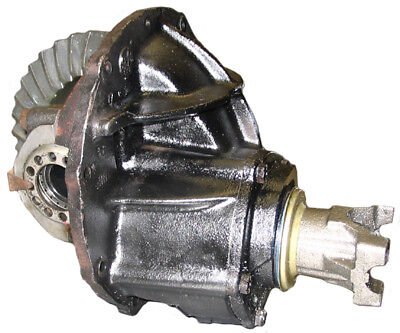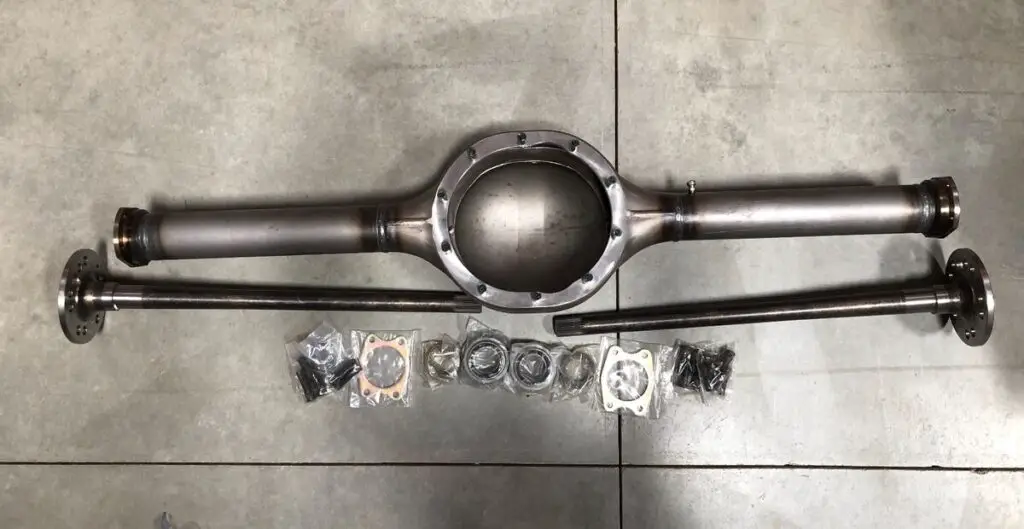The Ford 9-Inch Axle: Everything Bullnose Truck Owners Need to Know

The Ford 9-inch axle is a legend in its own right. If you’re into classic trucks or performance builds, you’ve probably heard about this axle’s reputation. It’s known for being tough, versatile, and easy to work on, which explains why folks still seek it out today. Whether you’re wrenching on a 1980-1986 Bullnose Ford truck or considering an upgrade, this article will fill you in on the 9-inch axle’s history, specs, strengths, and how it compares to other options out there.
Overview of the Axle
History
- The Ford 9-inch axle hit the scene in 1957. Ford needed a strong, reliable axle for their high-performance and heavy-duty vehicles, and the 9-inch delivered. It showed up in everything from muscle cars to full-size trucks. Over the years, its toughness earned it a spot in all kinds of vehicles, especially ones that see a lot of power or rough terrain. By the time Bullnose trucks rolled around in the early ‘80s, the 9-inch was already well-established as the go-to axle for anyone needing serious strength.
Applications
- During the Bullnose era, the Ford 9-inch wasn’t as common as it had been in earlier years, but it was still a solid choice for certain setups. While most Bullnose trucks came with the 8.8-inch axle, some heavy-duty models and performance builds used the 9-inch for its extra strength. It’s particularly popular in the aftermarket for those looking to upgrade their drivetrain for off-roading, towing, or high horsepower applications.
Technical Specifications
Axle Type
- The Ford 9-inch is a solid rear axle, the kind that’s built to take a beating. It features a removable third member, which makes gear swaps a lot easier. That’s one reason why hot rodders and racers love this axle—you can change the gears without messing with the housing.
Axle Shaft Splines
- The standard 9-inch axle came with 28-spline shafts, but 31-spline versions are common, especially in high-performance or heavy-duty setups. If you’re planning to push serious power through your Bullnose, 31 splines are the way to go. More splines mean more strength, so the axle can handle higher torque without twisting.
Ring Gear Size
- The 9-inch gets its name from the diameter of the ring gear: 9 inches. This larger ring gear allows the axle to handle more torque than smaller axles. That’s why it’s favored in high-horsepower builds, whether you’re on the drag strip or out on the trails.
Gear Ratios
- The 9-inch axle offers a wide range of gear ratios, from 2.47:1 to 6.14:1. This versatility is one of its strong points. Lower ratios (higher numerically) give you better acceleration, which is great for off-road and racing. Higher ratios (lower numerically) are better for cruising and fuel economy. Common ratios like 3.50:1 or 4.11:1 strike a good balance for most uses.
Weight Rating
- The Ford 9-inch axle is known for its strength, with a gross axle weight rating (GAWR) that can handle heavy loads. Depending on the setup, it’s rated anywhere from 3,000 to over 5,000 pounds. This makes it a popular choice for trucks that need to tow, haul, or hit the trails without worrying about breaking an axle.
Dimensions
- The overall width of the 9-inch axle can vary, but it generally measures between 61 and 65 inches from flange to flange. The axle tubes are typically 3 inches in diameter, providing plenty of strength to handle the toughest conditions.
Axle Weight
- The 9-inch axle weighs around 200 pounds, depending on the configuration. It’s heavier than the 8.8-inch axle, but that extra weight is part of what makes it so strong. If you’re swapping from a lighter axle, keep in mind that the added weight can affect your truck’s handling and fuel economy slightly.
Fluid Capacity
- This axle typically holds around 2.5 to 3 quarts of gear oil. Keeping the fluid at the right level is crucial for the longevity of your axle, especially if you’re running high gear ratios or using the truck for towing.
Axle Housing Design
- One of the standout features of the Ford 9-inch axle is its modular housing design. The third member, which includes the differential, pinion gear, and ring gear, can be removed from the front of the axle housing. This makes gear swaps and differential service much easier compared to other axles. Additionally, the housing’s design allows for stronger pinion support, reducing deflection under load and improving durability.
Pinion Support and Bearing Size
- The 9-inch axle is known for its robust pinion support. It features a larger rear pinion bearing, which provides better support and reduces the likelihood of pinion deflection under high loads. This design is part of what makes the 9-inch so durable, especially in high-torque applications. The axle’s third pinion bearing is a unique feature that adds extra strength, making it ideal for heavy-duty and performance use.
Center Section Variants
- Over the years, various center sections (also known as third members) have been developed for the 9-inch axle. The most common ones are the “WAR” case and the “N” case. The “N” case is particularly sought after for its reinforced design, which is stronger and more durable than the standard case. If you’re building a high-horsepower Bullnose, opting for an “N” case third member can provide additional peace of mind.
Strengths and Capabilities
Durability
- Durability is where the Ford 9-inch really shines. It’s built to handle high torque loads, which is why it’s a favorite for performance vehicles and heavy-duty trucks. The 31-spline version, in particular, is almost bulletproof, making it ideal for off-road rigs and vehicles with big power under the hood.
Aftermarket Support
- The 9-inch axle enjoys one of the largest aftermarket followings of any axle. Whether you need gears, differentials, or axle shafts, you’ll find a huge selection of parts. This means you can customize the axle to suit your needs, whether you’re looking for better traction, stronger gears, or just want to beef up your Bullnose for off-roading.
Versatility
- The versatility of the 9-inch axle is one of its biggest selling points. It’s equally at home in a drag car, a rock crawler, or a tow rig. Whatever you need your Bullnose to do, the 9-inch can be built to handle it.
Common Upgrades
- Popular upgrades for the 9-inch axle include installing a limited-slip differential, which improves traction by sending power to both wheels when needed. You might also upgrade to a higher spline count or swap in a different gear ratio to match your driving style.
Compatibility
- The 9-inch axle is compatible with various brake setups, from drum to disc. It’s also a good fit for different suspension systems, making it an easy choice for custom builds.
Maintenance and Care
Fluid Recommendations
- Ford recommends 75W-90 gear oil for the 9-inch axle, with the option of adding a friction modifier if you’re running a limited-slip differential. This keeps everything lubricated and running smoothly, which is key to preventing wear.
Regular Maintenance
- Regular maintenance involves changing the gear oil every 30,000 to 50,000 miles, depending on how hard you push your truck. It’s also important to check the axle seals and bearings for leaks or wear.
Common Issues
- The 9-inch is known for being tough, but like anything mechanical, it can have issues. One common problem is pinion seal leaks. If left unchecked, these can lead to low fluid levels and eventually damage the gears. Bearing wear is another concern, especially in high-mileage axles. If you hear a whining noise from the back of your truck, it might be time to inspect the bearings.
Tips for Longevity
- To keep your 9-inch axle running for the long haul, stick to the recommended maintenance schedule and avoid overloading your truck. If you’re using it for off-roading, be mindful of the terrain and avoid situations that could overstress the axle.
Comparison with Other Axles
Strength vs. Competitors
- When comparing the 9-inch axle to others, like the 8.8-inch or 7.5-inch, it’s clear that the 9-inch is the strongest of the bunch. It can handle more power and torque, making it the go-to choice for performance builds. While the 8.8-inch is more affordable and easier to find, the 9-inch wins out in sheer durability and customization potential.
Ideal Applications
- The 9-inch axle is perfect for trucks that see a lot of hard use, whether on the street, off-road, or towing heavy loads. If you’re building a Bullnose that needs to handle serious power or rough terrain, the 9-inch is the axle you want.
Installation Notes
Compatibility and Modifications
- Installing a 9-inch axle in a Bullnose truck is usually straightforward, especially if you’re replacing a smaller axle. You might need to make some adjustments to fit the larger axle shafts and ring gear, but nothing too difficult. If you’re upgrading from drum brakes to disc brakes, make sure your new setup is compatible with the 9-inch axle.
Brake and Suspension Considerations
- Depending on your brake and suspension setup, you might need to modify or upgrade certain components to work with the 9-inch axle. This could include new brake lines, calipers, or even suspension modifications to accommodate the axle’s strength.
Frequently Asked Questions (FAQ)
Q: What makes the Ford 9-inch axle so strong?
- A: The Ford 9-inch axle is known for its robust design, including a larger ring gear, a third pinion bearing, and a removable third member. These features reduce gear deflection and improve durability, making it ideal for high-torque applications.
Q: How does the 9-inch axle compare to the 8.8-inch axle?
- A: The 9-inch axle is stronger and more durable than the 8.8-inch, making it better suited for heavy-duty and performance applications. However, the 8.8-inch is lighter, more affordable, and easier to find, making it a good choice for less demanding setups.
Q: Can I upgrade my Bullnose truck from an 8.8-inch to a 9-inch axle?
- A: Yes, upgrading from an 8.8-inch to a 9-inch axle is a common swap for those looking to increase their truck’s durability and performance. The swap usually requires some modifications to the driveshaft, suspension, and brake system, but it’s a well-documented upgrade.
Q: What gear ratio should I choose for my 9-inch axle?
- A: The best gear ratio depends on how you plan to use your truck. Lower ratios like 4.11:1 are great for off-roading and acceleration, while higher ratios like 3.50:1 are better for cruising and fuel economy.
Q: Is the 9-inch axle compatible with modern disc brake setups?
- A: Yes, the 9-inch axle can be fitted with modern disc brakes. You’ll need to ensure the brake calipers, rotors, and lines are compatible with the axle’s housing and dimensions.
Q: How often should I change the gear oil in my 9-inch axle?
- A: It’s recommended to change the gear oil every 30,000 to 50,000 miles, depending on usage. If you use your truck for heavy towing or off-roading, consider changing the oil more frequently.
Q: What’s the best way to increase the strength of my 9-inch axle?
- A: To increase the strength of your 9-inch axle, consider upgrading to 31-spline axle shafts, using a reinforced “N” case third member, and installing a limited-slip or locking differential.
Q: Are there any common issues with the 9-inch axle I should watch out for?
- A: While the 9-inch is very durable, common issues include pinion seal leaks and bearing wear, especially on high-mileage axles. Regular maintenance and inspections can help prevent these problems.
Conclusion

The Ford 9-inch axle is a powerhouse, offering strength, versatility, and a huge range of customization options. Whether you’re building a street truck, an off-road rig, or a tow vehicle, the 9-inch axle is up to the task. With the right maintenance and a few smart upgrades, it’ll serve you well for years to come.

If you want more specific information on Bullnose Ford Trucks, check out my YouTube Channel!
For more information on Bullnose Fords, you can check out the BullnoseFord SubReddit or Gary’s Garagemahal. Both are excellent resources.